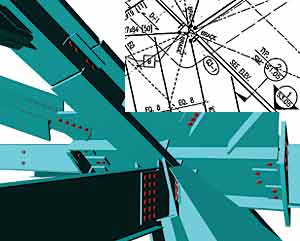Getting on Board with Building Information Modeling
Championing a Better Way
The structural steel industry has championed the use of 3-D modeling and the value of a vendor independent suite of interoperable design and fabrication programs since 2001. Those efforts have paid major dividends for steel-framed projects in bringing many of the promised benefits of BIM to the structural framing system segment of projects. The lessons learned by the structural steel industry can be utilized to form a roadmap for design professionals moving toward BIM implementation in their practices.
The structural steel industry recognized that errors made in producing, interpreting and integrating 2-D construction documents were plaguing the construction industry at a time when owners were demanding that projects be completed in less time, while staying on or coming in under budget. Complicating the issue was the continuing pressure being placed on architects and engineers to reduce fees and accelerate schedules. The end result was a decline in the quality of construction documents resulting in an avalanche of requests for information (RFIs) and change orders. This resulted in the stifling of innovative design, increased risk, escalated costs and extended schedules−the exact opposite of the desire of the project owner. The inability of design and construction team members to communicate and exchange data clearly and efficiently through the use of CAD-based technology created an environment that fostered adversarial relationships instead of collaboration and invited litigation. Selected structural steel projects, such as GM's engine plant, the Denver Art Museum expansion, and many others, are overcoming these barriers through the collaborative efforts of structural engineers and steel fabricators using 3-D modeling as a common design and construction vehicle. The transition to this process has not been easy, requiring a redefinition of the design and construction process.
|
Architects Making the Transition
Architects and architectural firms are beginning the process of transitioning from existing CAD environments to BIM, utilizing 3-D computer-aided design and construction, training staff, and applying BIM successfully on projects, as part of integrated design and construction teams. For that transition to be effective, BIM must be clearly understood in terms of its benefits, technology, and implementation.
Just as the success of CAD in transitioning building design from the drafting table to the computer required a cultural shift for the entire building design and construction industry, the transition from CAD to BIM tools and processes will require a similar shift as well. Internally, firms need to evaluate how this transition will affect their in-house technology, staff, and their ability to fund and support the transition. Externally, the firm must seek out appropriate projects and partners that they believe lend themselves to the BIM process and move forward.
SOM and Detroit's SmithGroup are two large, multi-office A/E firms making the transition to BIM. SOM's New York office is using 3-D modeling on a number of projects, including New York's Freedom Tower. "We're looking at BIM as being a complete database, as opposed to just 3-D information," says SOM's Galioto. The firm is using the model to arrive at and optimize intelligent solutions, test applications and simulations, such as thermal, daylight, glare, and computational fluid dynamics−the use of technology to study things that flow−for heating, ventilating, and air-conditioning. The firm also is using BIM for collision detection, points in the 3-D model that illustrate where the building's structure and MEP ducts, piping, and equipment improperly intersect with one another.
The next step for SOM is interoperability, the exportation of data and information via the 3-D model, as opposed to producing traditional 2-D drawings. The firm is working with curtain wall manufacturers on this process. "Interoperability is the challenge," Galioto says. "We are spending a lot of time finding ways to get the software to work together. It all comes down to the integration of multiple models. The structural steel industry is ahead of the curve on this."










